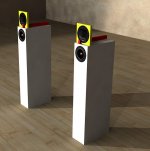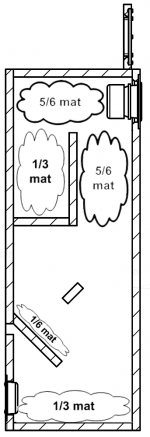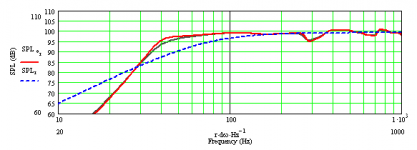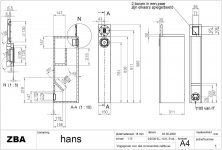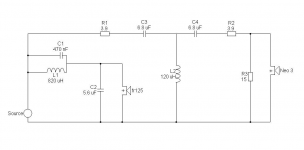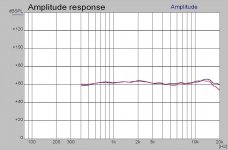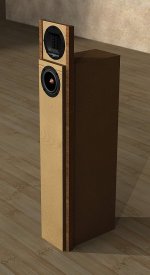I present here Hans, a 2 way floorstanding speaker with a special design, inspired by artists as Mondriaan and Rietveld
As tweeter, I chose the B&G Neo3PDR in dipole, the midwoofer is the FR125 from CSS that sits in a TL, crossover is ~4kHz 3rd order
As tweeter, I chose the B&G Neo3PDR in dipole, the midwoofer is the FR125 from CSS that sits in a TL, crossover is ~4kHz 3rd order
Attachments
for the TL I have made extensive use of MJK's allignment tables and his mathcad sheets to get a deep and flat response within the size of the cabinet and the position of the midwoofer at the top, and optimising the amount of stuffing. the bass output can be tuned by adjusting the stuffing in the bottom
Attachments
and here is the filter
it is a 3rd order for the tweeter, and 2nd order for the woofer. we tried a lower order filter, but found that there was too much overlap and the phase would not be paralel enough for this (effect: the individual curves were at some points above the summed response)
we also tried a lower X-over point, but a dip in the response of the Neo3 (some difraction, it would disappear for the larger part under 30°) made us go higher, with the added bonus of making better use of the FR125's mids
the woofer's coil has a small cap to act as a notch filter for the small hump at 7kHz in the FR125's response
it is a 3rd order for the tweeter, and 2nd order for the woofer. we tried a lower order filter, but found that there was too much overlap and the phase would not be paralel enough for this (effect: the individual curves were at some points above the summed response)
we also tried a lower X-over point, but a dip in the response of the Neo3 (some difraction, it would disappear for the larger part under 30°) made us go higher, with the added bonus of making better use of the FR125's mids
the woofer's coil has a small cap to act as a notch filter for the small hump at 7kHz in the FR125's response
Attachments
which results in the following response... (the 60dB is not correct of course... red is response under 15°)
and how is the sound? very good, as expected actually
a realy full and clean bass, nice mids, and a crisp and detailled high. listening slightly off axis results in an excelent imaging
and how is the sound? very good, as expected actually
a realy full and clean bass, nice mids, and a crisp and detailled high. listening slightly off axis results in an excelent imaging
Attachments
well... hadn't I already completed tidying the filter, and mounting it "final" in the enclosure I could have tried...
I'm sure both the FR125 and the Neo3 can handle the lower order filter.. might need some notch filter here and there and maybe some impedance correction. but I'm a bit worried about the off-axis response of the FR125 when crossing that high, maybe difficult to match it then... maybe in d'A with 2 3" drivers
I'm sure both the FR125 and the Neo3 can handle the lower order filter.. might need some notch filter here and there and maybe some impedance correction. but I'm a bit worried about the off-axis response of the FR125 when crossing that high, maybe difficult to match it then... maybe in d'A with 2 3" drivers
off axis ? Sure it's not perfect but IMO is better than you can imagine by the crude data.
And first order make miracles ....
I cross my audax HM100Zo at about 5Khz and no one have guessed
it
I think you can make the same with your CSS ( after all it is similar to the Vandersteen approch, no? )
Cheers,
Paolo
And first order make miracles ....
I cross my audax HM100Zo at about 5Khz and no one have guessed
it
I think you can make the same with your CSS ( after all it is similar to the Vandersteen approch, no? )
Cheers,
Paolo
nothing wrong with your english, I just never heard of Vandersteen loudspeakers  since I build my own, I have lost touch with the ready made stuf
since I build my own, I have lost touch with the ready made stuf 
but this approach is also used in DIY land... but in this case it just didn't work out so we went for higher order x-over.. but crossing higher might also have worked... something for the next project
 since I build my own, I have lost touch with the ready made stuf
since I build my own, I have lost touch with the ready made stuf but this approach is also used in DIY land... but in this case it just didn't work out so we went for higher order x-over.. but crossing higher might also have worked... something for the next project
Hi,
I think is important always confrontate our DIY creatures with the best
speakers the market offer
There is no other way to appurate the value of your work
return to your nice 2 way, I think one have to experimentate more different crossovers as possible: same conditions , different results.
One serious DIYer/listener can expend months and months on this
rather makinkg compulsively news cabinets with news drivers......
You have a "wideranger" that can be crossed everywhere you want.
So 6 dB is possible.
In the case you are worried for the different dispersion carachteristic
of the 2 drivers you can always ruotate 90 degrees the Neo3!
Cheers,
Paolo
I think is important always confrontate our DIY creatures with the best
speakers the market offer

There is no other way to appurate the value of your work
return to your nice 2 way, I think one have to experimentate more different crossovers as possible: same conditions , different results.
One serious DIYer/listener can expend months and months on this
rather makinkg compulsively news cabinets with news drivers......
You have a "wideranger" that can be crossed everywhere you want.
So 6 dB is possible.
In the case you are worried for the different dispersion carachteristic
of the 2 drivers you can always ruotate 90 degrees the Neo3!

Cheers,
Paolo
as I was looking back at this thread, i read your comment here.. this is just what I recently did as I took Hans to a friend who has a pair of BKS 107mk2 Supreme since it was this speaker that gave me the inspiration to design Hans... to make a long story short: my friend was stunned... in the bass department it was no contest, the BKS is very poor (but that suits his musical taste), the high the BKS had only a hair in front, just this bit lighter, with more ease. not bad for a speaker 7 times cheaper...inertial said:I think is important always confrontate our DIY creatures with the best speakers the market offerThere is no other way to appurate the value of your work

hi,
forgot one important thing:
I suggest to use this as "monitor" for your x-overs experimentations
http://www.zaphaudio.com/tidbits/HIVI-B3S-FR.gif
Believe me, this "thing" destroy 95% of all speaker you can imagine ( DIY or commercial)

Cheers,
Paolo
forgot one important thing:
I suggest to use this as "monitor" for your x-overs experimentations
http://www.zaphaudio.com/tidbits/HIVI-B3S-FR.gif
Believe me, this "thing" destroy 95% of all speaker you can imagine ( DIY or commercial)


Cheers,
Paolo
why would I want to use a B3S in x-over experiments when i have an FR125 or an Alpair6 available? most small FR will surprise 95% of the people used to normal speakers, and the B3S is in the FR field not among the top...... (for it's money it is pretty good, but most will team it up with a tweeter to avoid having to listen to its cone breakup)
I have no measurements on the BKS unfourtunately
I have no measurements on the BKS unfourtunately
Oh, I was not understood this .Henkjan said:why would I want to use a B3S in x-over experiments when i have an FR125 or an Alpair6 available?
In this case , use the alpair6........
most small FR will surprise 95% of the people used to normal speakers, and the B3S is in the FR field not among the top...... [/B]
Who say this, excuse me?
Do you have also the B3S ?
(for it's money it is pretty good, but most will team it up with a tweeter to avoid having to listen to its cone breakup) [/B]
If you have B3S as zaph project ,OK, this is your opinion. Mine is different.
I have no measurements on the BKS unfourtunately [/B]
Thanks the same. I was curious to see if it is like Thiel or Vandersteen or other.....
Cheers,
Paolo
just digging this up because I got some questions on some points in the design which relate to differences on stuff used on the opposite sides of the Atlantic.
one was the type of and amounts of stuffing. I used "Sonofil" (from Intertechnik), the equivalent available in the US would be acoustastuff or wool. Sonofil comes in 'mats' (2 mats in 1 bag), so I used that as a unit of measure to show how much stuffing goes where, I am used to cut up the pieces so it is easy to distribute correctly. "1 mat" weighs about 55 gram. So "5/6 mat" would be 46 gram, or 1.62 ounces in imperial units.
The other question was on the AWG used for the inductors (in Europe we use the diameter of the wire in mm). For the large inductor I used 1.6mm wire, so equivalent to 14AWG, if you cannot get that 16AWG (equivalent to 1.4mm) will also be fine. For the smaller inductor the AWG is not important.
I hope this helps
one was the type of and amounts of stuffing. I used "Sonofil" (from Intertechnik), the equivalent available in the US would be acoustastuff or wool. Sonofil comes in 'mats' (2 mats in 1 bag), so I used that as a unit of measure to show how much stuffing goes where, I am used to cut up the pieces so it is easy to distribute correctly. "1 mat" weighs about 55 gram. So "5/6 mat" would be 46 gram, or 1.62 ounces in imperial units.
The other question was on the AWG used for the inductors (in Europe we use the diameter of the wire in mm). For the large inductor I used 1.6mm wire, so equivalent to 14AWG, if you cannot get that 16AWG (equivalent to 1.4mm) will also be fine. For the smaller inductor the AWG is not important.
I hope this helps
- Status
- This old topic is closed. If you want to reopen this topic, contact a moderator using the "Report Post" button.
- Home
- Loudspeakers
- Multi-Way
- design floorstanding 2way with Neo3 in dipole and Fr125 in TL
